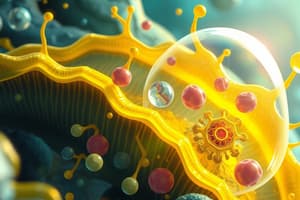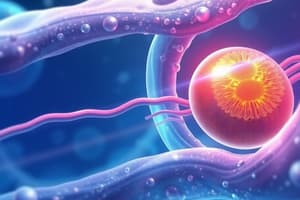Podcast
Questions and Answers
What is the primary function of the cell membrane?
What is the primary function of the cell membrane?
- To regulate the movement of substances in and out of the cell. (correct)
- To produce energy for cellular functions.
- To provide structural support to the cell.
- To transport nutrients across the cell wall.
Which of the following components makes up the largest percentage of the cell membrane?
Which of the following components makes up the largest percentage of the cell membrane?
- Carbohydrates
- Proteins (correct)
- Nucleic acids
- Lipids
Which mechanism of transport involves movement against an electrochemical gradient?
Which mechanism of transport involves movement against an electrochemical gradient?
- Osmosis
- Simple diffusion
- Facilitated diffusion
- Active transport (correct)
What thickness is the cell membrane approximately?
What thickness is the cell membrane approximately?
Which ion does the cell membrane help to control in both the intracellular and extracellular fluids?
Which ion does the cell membrane help to control in both the intracellular and extracellular fluids?
What is NOT a function of the cell membrane?
What is NOT a function of the cell membrane?
What type of transport includes molecules moving down their electrochemical gradient?
What type of transport includes molecules moving down their electrochemical gradient?
Which component accounts for only 3% of the cell membrane's structure?
Which component accounts for only 3% of the cell membrane's structure?
What type of transport uses energy directly from the hydrolysis of ATP?
What type of transport uses energy directly from the hydrolysis of ATP?
Which of the following statements is true regarding active transport?
Which of the following statements is true regarding active transport?
How does secondary active transport primarily generate its energy?
How does secondary active transport primarily generate its energy?
Which of the following correctly distinguishes active transport from simple diffusion?
Which of the following correctly distinguishes active transport from simple diffusion?
What is a defining characteristic of vesicular transport?
What is a defining characteristic of vesicular transport?
What process involves the trapping of extracellular material within vesicles formed by the cell membrane?
What process involves the trapping of extracellular material within vesicles formed by the cell membrane?
What occurs during exocytosis?
What occurs during exocytosis?
Which transport mechanism exhibits saturation and competition?
Which transport mechanism exhibits saturation and competition?
What process involves the engulfment of large-sized substances by the cell membrane?
What process involves the engulfment of large-sized substances by the cell membrane?
Which statement is true regarding simple diffusion?
Which statement is true regarding simple diffusion?
What characterizes facilitated diffusion compared to simple diffusion?
What characterizes facilitated diffusion compared to simple diffusion?
Which of the following best describes osmosis?
Which of the following best describes osmosis?
What is a key feature of active transport?
What is a key feature of active transport?
How does water primarily enter the cell by osmosis?
How does water primarily enter the cell by osmosis?
What distinguishes facilitated diffusion from simple diffusion?
What distinguishes facilitated diffusion from simple diffusion?
Which characteristic is NOT true for simple diffusion?
Which characteristic is NOT true for simple diffusion?
Flashcards
Cell Membrane
Cell Membrane
A thin, elastic, semi-permeable barrier around animal cells.
Cell Membrane Functions
Cell Membrane Functions
Separates cell contents, controls transport, maintains environment and generates transmembrane potentials.
Cell Membrane Composition
Cell Membrane Composition
Lipids (42%), proteins (55%), and carbohydrates (3%).
Membrane Transport Types
Membrane Transport Types
Signup and view all the flashcards
Passive Transport/Diffusion
Passive Transport/Diffusion
Signup and view all the flashcards
Simple Diffusion
Simple Diffusion
Signup and view all the flashcards
Facilitated Diffusion
Facilitated Diffusion
Signup and view all the flashcards
Osmosis
Osmosis
Signup and view all the flashcards
Active Transport
Active Transport
Signup and view all the flashcards
Primary Active Transport
Primary Active Transport
Signup and view all the flashcards
Secondary Active Transport
Secondary Active Transport
Signup and view all the flashcards
Active Transport Characteristics
Active Transport Characteristics
Signup and view all the flashcards
Vesicular Transport
Vesicular Transport
Signup and view all the flashcards
Endocytosis
Endocytosis
Signup and view all the flashcards
Exocytosis
Exocytosis
Signup and view all the flashcards
Transmembrane Potential
Transmembrane Potential
Signup and view all the flashcards
Membrane Receptors
Membrane Receptors
Signup and view all the flashcards
Signal Transduction
Signal Transduction
Signup and view all the flashcards
Cytoplasm
Cytoplasm
Signup and view all the flashcards
Extracellular Fluid (ECF)
Extracellular Fluid (ECF)
Signup and view all the flashcards
Isotonic Solution
Isotonic Solution
Signup and view all the flashcards
Hypertonic Solution
Hypertonic Solution
Signup and view all the flashcards
Hypotonic Solution
Hypotonic Solution
Signup and view all the flashcards
Transmembrane Protein
Transmembrane Protein
Signup and view all the flashcards
Study Notes
Cell Membrane
- A thin, elastic, semi-permeable membrane surrounding every animal cell
- 7.5 nm thick
- Controls what enters and exits the cell
Functions of the Cell Membrane
- Separates the cytoplasm from the extracellular fluid (ECF)
- Maintains the cell's internal environment
- Transports macromolecules into and out of the cell
- Controls the distribution of ions like sodium and potassium
- Generates transmembrane potentials
- Contains receptors for hormones and transmitter substances, important for signal transduction
Components of the Cell Membrane
- Composed of lipids, proteins, and carbohydrates
- 42% lipids, 55% proteins, 3% carbohydrates
Transport through the Cell Membrane
- Three main mechanisms: passive transport, active transport, and vesicular transport
Passive Transport (Diffusion)
- Movement of substances across the cell membrane down its electrochemical gradient
- Requires no energy
- Three types: simple diffusion, facilitated diffusion, and osmosis
Simple Diffusion
- Movement of substances across the cell membrane without the need for carrier proteins
- Occurs through the lipid bilayer or watery protein channels
- Characterized by:
- Occurs down an electrochemical gradient
- No energy is required
- Not rate-limiting
- Not saturable
Facilitated Diffusion
- Diffusion of substances across the cell membrane down an electrochemical gradient, requiring carrier proteins
- Characterized by:
- Occurs down an electrochemical gradient
- No energy is required
- Requires the presence of a transport carrier protein
- Rate-limiting and saturable
Osmosis (Diffusion of Water)
- Water diffuses through the lipid bilayer very rapidly due to its small size and high kinetic energy
- Water moves from high to low concentrations of water
Active Transport
- Movement of substances across the cell membrane against its electrochemical gradient
- Requires energy
- Two types: primary and secondary active transport
Primary Active Transport
- Obtains energy directly from the hydrolysis of ATP
- Example: Sodium-Potassium Pump
Secondary Active Transport
- Uses energy stored in a concentration gradient (like sodium)
- Example: Sodium-Glucose co-transport
Active Transport Characters
- Occurs against the electrochemical gradient
- Requires energy
- Requires the presence of a transport carrier protein
- Exhibits saturation and competition
Vesicular Transport
- Mechanism by which large sized substances can cross the cell membrane
- Two types: endocytosis and exocytosis
Endocytosis
- Extracellular material is trapped within invaginations of the cell membrane
- Forms vesicles
- Active process requiring energy
Exocytosis
- Intracellular material is trapped within vesicles
- Vesicles fuse with the cell membrane, releasing their contents into the ECF
- Active process requiring energy (e.g. release of hormones, digestive enzymes)
Studying That Suits You
Use AI to generate personalized quizzes and flashcards to suit your learning preferences.





